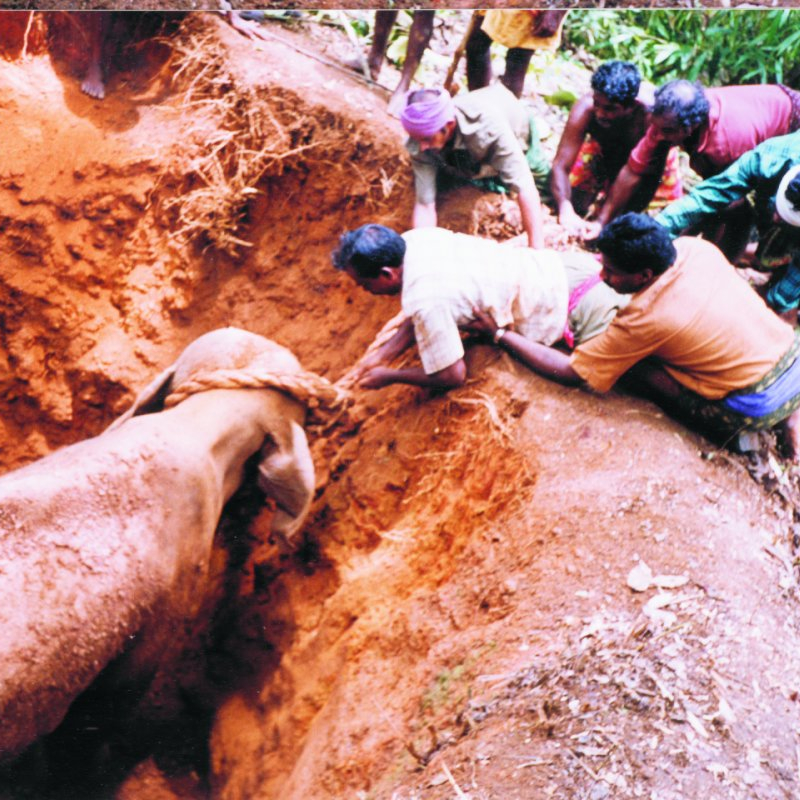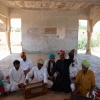The history of domesticating elephants in India can be traced to about 6000 BCE on the basis of rock paintings, says D.K. Lahiri-Choudhury in The Great Indian Elephant Book. Seals excavated from the sites of Indus Valley Civilisation (c. 2500–1500 BCE) suggest the presence of domesticated elephants in the region. Aryans—upon their supposed entry to the subcontinent around 1500 BCE must have learnt the art of elephant rearing from native populations.
The use of elephants in war has been recorded in works on the military history of India, including the role that war elephants played in the battle between Alexander the Great and King Porus, the ruler of what is present-day Punjab, on the banks of the Jhelum River in the fourth century BC.[1] Roy goes on to suggest that by around 300 BCE, a military transformation occurred in the subcontinent resulting in the formation of a four-fold army (chaturnaga vahini), centred around horse-drawn war chariots, supplemented by cavalry, infantry with weapons and elephants (hasti).[2]
The Arthashastra (compiled and developed over a span of five centuries from the second century BCE to the third century CE) elaborates on the art of handling elephants, as well as on various aspects of their physiology and health. It even mentions an ‘overseer of elephants’, whose duties included the care and training of elephants. During the reign of Emperor Ashoka (273–232 BCE), elephants came to symbolise Buddhism; Ashokan edicts also refer to the setting up of hospitals for the treatment of elephants and other animals.
After the collapse of the Gupta Empire (c. CE 320–550), the new regional armies depended primarily on elephants, supported by heavy cavalry and a sword-bearing infantry. Roy argues that the use of war elephants as a ‘strike corps’ in the subcontinent marked another instance of military transformation[3] and suggests that the indigenous military system followed by the Rajput kingdoms in the medieval period allowed the Islamic Turks from Afghanistan and beyond to conquer India and establish sultanates in Delhi; the cumbersome elephant-infantry-based armies of the Indian subcontinent between the ninth and twelfth centuries could not withstand the light and fast ‘horse-mounted archery of the Turks’.[4] Later, the sultanates adopted Indian systems in warfare, including war elephants. In the eighteenth century, military strategy again went a transformation and under the European colonisers, elephants and cavalry archers were used less and infantry with light firearms largely formed the army.
The trajectory of war elephants indicates that the process of capturing and domesticating wild elephants was practised throughout the millennia.
The British army in India used elephants both for its artillery wing and its commissariat and it set up a catching establishment in Dhaka, in what is now Bangladesh. This was later closed as it led to over exploitation in the main area of operations, the Garo Hills and the establishment was shifted to Burma in 1900. The high demand for elephants coupled with low availability lured several people, including foreigners, into the business.
The elephant-catching industry was controlled by the colonial Forest Department. The forest areas allocated for catching elephants were divided into leases or lots (mahals), and rights were given to mahaldars who had to pay a royalty to the government for each animal captured, an amount that varied depending on sex and type. The mahaldars engaged men who worked with trained domestic elephants to capture wild elephants. The system was often cruel and injured the wild elephants and therefore, in 1909, a young officer named A.J.W. Milroy drew up a set of rules to rationalise and humanise catching operations, which came into force in 1922. He abolished the old system and introduced the Khedda (Elephant Capture) Department. All the stakeholders, from the government to the stockade man, benefited from this change. A veterinary officer was appointed, as was a special officer who was assisted by a jemandar (supervisor) and a mahout (a seasoned elephant handler).
Elephants were also used for purposes other than the military; tea gardens maintained elephants for transportation across rivers, district officials in Assam and North Bengal used them to carry baggage during tours, the timber industry used them for hauling and the wealthy rode them during shikar (big game hunts). P.D. Stracey, tracing the history of elephant capture in his book Elephant Gold, says that for thousands of years people used domesticated elephants in religious processions and marriage ceremonies. Temples in South India kept elephants and the rich considered it prestigious to hire elephants for festivals; in the north, Maharaja Jung Bahadur of Nepal owned a thousand elephants in the 1800s. Such demands led to the rise of elephant trading at melas (fairs) such as the Sonepur, Kharga, Singeswar and Nak-mard melas.[5] In the ‘Introduction’ to his landmark work on elephants, D.K. Lahiri-Choudhury argues that elephant hunting was also promoted during the British period as a symbol of sportsmanship and a way to establish one’s superiority among one’s peers.[6]
Historically, several methods have been used to capture elephants in different regions within the country. In fact, Sanskrit literature mentions five methods of capturing wild elephants:
- Pit-fall method
- Khedda method (using pens or stockades)
- Melashikar or lassoing method
- Decoy method (using female elephants as decoys)
- Capture using nooses concealed on the ground
The Pit-fall Method
Prevalent in South India, this was an inexpensive but primitive method of capturing wild elephants. One of the most detailed descriptions of the process of pit making and capturing is provided by T.F. Bourdillon in the Report on the Forests of Travancore. He describes pits—four to five metres deep, four metres square at the top and three metres square at the bottom, so that the walls had a slight incline—dug along elephant paths. The pit was filled up to two metres deep with brushwood, twigs and bundles of grass to cushion the elephant’s fall. The pit opening was made to look as natural as possible by camouflaging it with a lattice of split bamboo sticks, which were covered with grass and leaves. The excavated earth would be moved some distance away. The pit was inspected daily, but even if it was not, he writes that the trumpeting of the elephant when it fell in would be loud enough to be heard as far as a kilometre away.
Once an elephant was trapped, the necessary people would be notified, and expert mahouts with kumkis (trained elephants) would arrive to bring the trapped elephant out of the pit as quickly as possible—a maximum of twenty-four hours. In case the process was delayed, a shelter would be constructed over the pit to protect the elephant from direct sunlight. In Kerala, according to Bourdillon, the pit would be divided by a partition made of poles. Men would descend into the unoccupied space, and, putting their hands through the bars of the partition, manage to tie ropes around the neck and hind legs of the animal. Water would be poured over it to keep it cool and drinking water would be provided through a bamboo tube.[7]
When the kumkis arrived, two or three logs would be placed across the top of the pit, so that the men could walk across and work comfortably. A noose was made, usually of the bark of the ‘elephant rope tree’ (Sterculia villosa), known in Malayalam as vakka kayar. Ropes would be used to remove the elephant from the pit. A wooden peg would be slipped through the rope at the end of the noose to prevent it tightening further and strangling the animal. The noose would be kept open with hooked sticks and a white cloth would be dangled over the elephant to attract its attention. When the trapped elephant raised its trunk to reach up for the cloth, the noose was dropped over animal’s head and around the neck. After the noosing of the neck, one or two of the animal’s hind legs would be secured.[8]
When the procedure of noosing and tying was over, the ends of the neck ropes and leg ropes would be fastened to one or more kumkis and the pit would be filled with bundles of wood and grass to allow the trapped elephant to scramble out. The captured elephant would then be taken to the training camp and secured inside the kraal (enclosure) and all ropes would be removed. The elephant would then be treated kindly and given constant attention and intensive training.
In Tamil Nadu, elephants older than 50 years were not captured. If an aged elephant fell into the pit, it would be released immediately. Small calves were also not preferred, mostly because of the high cost of bringing them up. The ideal age for a captured elephant was considered to be between 18 and 25 years. In Kerala, many a times, tuskers would be given to temples for religious ceremonies and festivals and female elephants retained by the Forest Department to work, for example, in timber transportation.
In his work, Bourdillon refers to Lt. Arthur, whose book Memoir of Travancore (1810) mentions that the government used to allow people to cut pits for these animals on payment of a tax per pit. The elephants thus taken became the property of the persons who dug the pits. Parties of hunters, timber men, or others, whenever they went into forests, dug pits around their camps with the double objective of protecting themselves and capturing elephants or other wild animals. From 1810 onward, the government started digging pits on its own account. But private groups were still allowed to have inam pits, as they were called. The elephants captured by private persons had to be sold to the government at Rs 150 a head. By 1875, inam pits were prohibited.[9] According to Bourdillon, in 1873–74, the conservator suggested that the government adopt some other means of capture because of the great mortality among the elephants that fell into pits. In Travancore, about 50 per cent of the elephants that fell into pits either died or escaped. Some of the captured elephants later died from injury.[10]
According to his report, the conservator recommended the setting up of a khedda along the lines of Sanderson’s khedda in Mysore and the work was commenced in 1874–75. The khedda was successful for about nine years and it resulted in the capture of about a hundred animals. However, the number of elephants captured became less and less subsequently, and the khedda was also abandoned.
The Khedda Method
The word ‘khedda’ is derived from the Hindi word khedna, which comes from the Sanskrit word khet, or ‘to drive’. The most important principle in this stockade method was keeping the captured animal as safe and free from injuries as possible. In a khedda operation, herds of elephants were driven into a stockade and then captured.
The earliest detailed account of the khedda method is described by G.P. Sanderson (1907). Some of the academic exploration in the field can be found in P.D. Stracey (1964, 2009), D.K. Lahiri-Choudhury (1999), K.N. Ninan (2012) and so on.
In the older method, practised in North India, a large round enclosure surrounded by a trench would be built, across which a single bridge was left to admit the elephants. The trench was approximately 30 feet wide and 24 feet deep and the excavated soil was used to form a steep bank on its outer side. Female decoy elephants were driven into the enclosure to lure the males of the wild herd into the trap, after which the herd would follow. People would keep watch from hiding places, and once a wild herd entered the enclosure, the bridge would be demolished, trapping the herd. The captured elephants would be kept without water and food for some days to weaken them, and then the bridge would be rebuilt and some kumkis introduced into the enclosure. Once subdued, the legs and necks of the captured elephants would be tied with ropes thrown from the backs of the kumkis. In the older technique, incisions were made on the neck of the elephants with knives so that the ropes would bite into the flesh directly and the elephant will be subjugated quickly and with less effort.
In the refined practice, a wooden wall, one metre high, would be built around the enclosures, and sometimes a trench 2 metres wide and 1.3 metres deep would be dug just inside the stockade walls. A one-metre-wide opening would be provided for entry into the enclosure. Once the elephants entered the enclosure, the opening would be shut off. The wooden stockades evolved differently in different areas.[11] In the north, a simple stockade wall with a trench inside was used, while in eastern India, due to the softer nature of the soil, a palisade wall was used to reinforce the trench.
The khedda method was virtually unknown in South India until, in the seventeenth century, Hyder Ali tried to capture elephants using this method, but he and his son Tipu Sultan were unsuccessful in the attempt. A similar effort in 1867 by a British army officer, Colonel Pearson, also failed. The first kumkis in Mysore were reportedly brought from Myanmar and with them came the method of leading the captured elephant with long ropes (or phands) tied to two or more kumkis in front and behind. Methods differed depending on the region. In Nepal, for example, the kumki and the captured elephant were tied together by the neck, whereas in Assam, the captive was tied beside the kumki.[12]
The first successful khedda in Mysore was conducted in 1873 by G.P. Sanderson, a British officer of the Irrigation Department. He had been put in charge of elephant capturing by the Mysore Government. During this operation, 53 elephants were captured; however, he was unsuccessful in his second attempt in 1874 at Kardihalli. By this time, the Kurumba tribals and others had also learnt the art of the khedda system.[13]
The Mysore khedda system was very different from the methods practised in the eastern Indian states of Assam, Bengal and Odisha. Mysore kheddas were done with as many as 40 kumkis and about a thousand men and the driving of the herd occurred during the day. The stockade would extend over five acres. In Mysore, the kheddas were conducted largely in two areas: Budhipadaga in the Chamarajanagartaluka and Kakanakote in the Heggadadevankote taluka.
In Kakanakote, the khedda took place in winter on the banks of the Kabini River, primarily during January and February when the forest is relatively dry but has enough water. The stockade would be built on the riverbank near the place where elephants habitually came to drink water or cross the river. The stockade was spread over a five-acre area, with a single entrance closed by a sliding door that could be operated by kumkis. The entrance of the stockade was strategically placed on the part of the bank where elephants could cross the river easily.
The usual haunts of the wild elephants would be identified and then about 2000 men would be deployed as sentries at strategic points. These men were experts in elephant behaviour and kept watch on the elephants. The moment the elephants began to move towards the water, the men would stealthily converge on them from three sides. The herd, at that point, could be as far away as 12 kilometres from the stockade. Men were then positioned on both sides of the elephants’route to the stockade, every 20 metres or so. At an appropriate moment, shots would be fired into the air, and at the same time, drums and tin cans would be beaten loudly. Fires would be lit, and men would carry split bamboos, which make the sound of a fire-cracker when slapped against the ground. The scared elephants were thus forced into a predetermined route, with elephants that strayed out of the ring being driven back, and the ring gradually being made smaller and smaller.
Armed men on kumkis would follow the herd with beaters, until finally the herd—elephants of all ages and sizes—would enter the water, trumpeting loudly. The men would continue shouting, beating the drums, and bursting crackers until the herd was driven into the stockade, its walls camouflaged with leaves and grass. Once the leader of the herd was inside, others would readily follow, and as soon as the last elephant was in, the entrance door would be shut. The kumkis would be taken inside with armed men on their backs. Sometimes the wild elephants and kumkis would fight, but eventually the wild elephants were singled out one by one and secured with ropes and nooses around their necks. Old, handicapped and young elephants would be set free.
R. Sukumar, in The Asian Elephant: Ecology and Management, provides an ecological analysis of elephant–human interaction and its implications for the conservation of elephants. He writes that it would not be an exaggeration to state that between 30,000 and 50,000 elephants were captured or killed in India between 1868 and 1980. He adds, ‘Entire herds were taken in the north but only solitary animals in the south, with the exception of the khedda captures in the southern Mysore state’.[14]
In Mysore, the practice was primarily given up because of its inherent cruelty. Stracey cites incidents that highlight this cruelty. In addition, elephants could sometimes be shot during capture operations. Sanderson gives shocking figures for the number of elephants shot. In 1889, 24 elephants were shot; in the 1890 Kakanakote khedda, 18 were shot; in 1891, 16 were shot; and in 1896, 58 out of 170 were shot by ‘Khedda’ Shamienger!
Mela Shikar or Lassoing Method
Mela shikar refers to the lassoing or noosing of wild elephants from the backs of kumkis. This was considered to be the most exciting method of elephant capture, requiring great skill and courage on the part of both the kumkis and the riders. Wild herds were approached silently and stealthily, and then kumki elephants, expertly ridden, would give chase, while the riders would noose individual elephants. The success of this method depended a lot on the teamwork between the kumki, the mahout and the phandi (mahouts trained in the particular skill of noosing wild elephants)[15] who did the actual noosing.
This method was widely practised in Myanmar, Thailand, Vietnam, Laos and Cambodia. In India, this method was practised predominantly in Assam. It was less expensive than running a khedda. The lassoing team—the kumki, phandi and mahout—would be assisted by the kamla,[16] the grass cutter whose job it was to provide food and water to the kumkis. In Assam and Bengal, the rope used to tie elephants was made of jute.
The shikar kumkis hunted in small parties, assisting each other whenever required. The daily search for a wild herd would start early in the morning and camps would be frequently shifted. They remained in the forest until a catch was made or rations ran out. During the operation, the mahout would occupy the rear end of the saddle pad, and not the front as would usually be the case. He would hold on to a sling with one hand and use the other hand to control the kumki. The phandi stood or sat on the kumki’s back with slings tied to the animal. There were specific rules for managing kumkis, handling them, tying the phand (rope) and even for folding the phand on the kumki’s back.
As the mahout rode the kumki near the target elephant, the phandi would throw the noose over the head of the target elephant, and then tighten it so that the elephant would not be able to use its trunk to grab it. The phandi would haul in the slack on the noose, tie a check rope to avoid strangulation, and then attach the rope from the captured elephant to the chest rope of the kumki. The mahout would then allow the kumki to go along with the noosed elephant and stop it whenever needed.
Capturing solitary males required more than one kumki and phandi—several kumkis would be involved. Usually, a team of phandis would work together to capture larger numbers of elephants in a practice known as byleshikar. The pithashikar was practised in Nepal, where solitary elephants would be chased over great distances by small and fast kumkis until the exhausted elephant would take refuge in a water body or swamp. If the elephant was small enough, it would be noosed, while larger adults were secured with a rope tied in a figure-8 around their hind legs and then allowed to roam freely with the rope trailing behind.
Another form of mela shikar, practised in the Balrampur kheddas of northern India, is described by Stracey.[17] A large number of men armed with guns would be engaged as well as a number of kumkis. Herds in valleys would be prevented from escaping by armed men who guarded the ridges and drove the elephants back down to lower open ground. There, they would be intercepted by the khedda elephants who would be lined up in a crescent formation. The tame tuskers would then beat the wild ones into submission, who would then be noosed.
Decoy Method
This method was practised in South India, especially in the Mysore area. It was considered to be the most dangerous method as it was used to capture large males. A highly trained female kumki would be used as a decoy once a large solitary male was located. The decoy kumki, with a man concealed under a blanket on her neck or under her abdomen, would be sent out to graze next to the solitary bull. With time, the male, especially if in musth, would become completely infatuated with the decoy, who would continually move away until the male was exhausted, at which point his hind legs would be tied and a noose tied around his neck, and he would be taken to the training camp with the help of the kumkis.
Capture Using a Concealed Noose on the Ground
Stracey[18] describes this method, traditionally performed by a community of Muslims called Panikkans, who would capture elephants using a noose made of deer hide, about 25 feet long. These ropes would be spread on the ground along the elephant path, concealed under a few inches of soil and anchored to a tree. The area where the noose was concealed would be strewn with things edible to elephants. The men would hide behind trees and secure the hind legs of the elephant as it passed. The book also mentions another method employed by the Panikkans where about 10 to 15 men would wait near the elephant path. A young animal would be selected for chasing, a noose would be quickly slipped around a hind leg and the other end of the noose tied to a tree. The other leg would then also be noosed and a rope tied around the neck. The animal would then be taken forcibly to a nearby village. This method was both adventurous and dangerous.
Chemical Immobilisation or Chemical Capture
Chemicals, in the form of an anaesthetic on an arrowhead or in food, were also used to capture elephants.
The traditional methods mentioned here were once used to capture elephants and put them to work; they were frequently unsuccessful in terms of survival of the captured elephants. Since the enactment of the Wildlife (Protection) Act of 1972, however, elephant capture is banned for all purposes in India except as a measure of population management, as a conflict-mitigation measure, for the rescue and rehabilitation of elephants in distress, or for veterinary intervention.
Today, chemical capture ranges from immobilisation to tranquilisation to anaesthetisation, depending on the drug and dosage. It is preferred because it can be used to target a specific individual in different situations. Chemical capture involves a series of steps—selection and identification of the elephant, assessment of its health and physiological features, understanding the ecological and physical features of its habitat, selection of the appropriate drug and calculation of dosage, selection of appropriate remote injection device,darting of the target animal by means of a remote drug delivery system, tracking of the darted elephant, checking for the level of anaesthesia, checking that the immobilised elephant is positioned safely, roping and tying it up, kumki placing, reversal of the immobilised elephant, building a temporary road in thick jungle, and loading, transporting, unloading and en-kraaling of the elephant.
The commonly used drugs for chemical capture are etorphine hydrochloride, fentanyl, carfentanyl, acepromazine, xylazine, ketamine, azaperone, meditomidine and detomidine. These drugs are used alone or in combination. There is no single immobilisation system that is universally applicable. A large array of chemical agents is available for immobilising elephants, each of which has its own effects and limitations and must be used only by an expert who understands drug interactions.
The success of chemical capture depends on proper planning, precautions, teamwork and professionalism. It is often carried out in remote and inhospitable terrains. The men involved in this operation group divided themselves into three teams: management team, tracking team and darting team. Thorough knowledge of the habitat, terrain, location of waterholes and road network is essential. The animal should not be darted near deep water or rough terrain. The target individual should be studied for its state of health, age, weight and physiological condition like musth or an advanced stage of pregnancy. Diseased, weak, old, emaciated, and debilitated animals should be avoided. A suitable drug should be selected based on the animal and the surrounding environmental conditions and drug dosages should be formulated after considering the elephant’s weight and health.
A cooler time of day is better for darting; an ambient temperature of between 10°C and 35°C is ideal. Search parties should be in place before darting, as quickly locating the darted animal is important in order to commence the post-capture procedure immediately. While noosing, a wooden peg must be driven through the rope at the end of the noose to prevent strangulation. The animal should be revived with an antidote and careful transportation including ensuring optimum vehicle speed.
Notes
[1] Roy, Warfare in Pre-British India, 33.
[2] Roy, Warfare in Pre-British India, 36.
[3] Roy, Warfare in Pre-British India, 76.
[4] Roy, Warfare in Pre-British India, 106.
[5] Stracey, Elephant Gold.
[6] Lahiri-Choudhury, The Great Indian Elephant Book, 33.
[7] Bourdillon, Report on the Forests of Travancore, 163–86.
[8] The expert worker who had to do the difficult job of noosing the elephant would not trust anyone but his brother-in-law to hold him by his waist band. It was in the brother-in-law’s interest to be careful because if anything happened to the man noosing the elephant, it would be the brother-in-law who would be responsible for maintaining his widow.
[9] Bourdillon, Report on the Forests of Travancore, 163.
[10] Bourdillon, Report on the Forests of Travancore.
[11] The ‘Karen method’ of Myanmar consisted of a simple stockade with a stout pair of funnel walls, gradually tapering and ending at a thick tree. Elephants were driven into this enclosure and then prevented from escaping by drop gates. The trapped elephant was tied by its legs to the walls of the stockade and some preliminary training would be given before it was removed from the stockade with the help of kumkis. This method was considered economical and was similar to the Upper Assamese hal and the South Indian kraal, where the captured animals were confined for a period of time before being taking out. Narsinghdeo, the ruler of Odisha in the thirteenth century, used the khedda method to capture elephants. Khedda scenes have been depicted in great detail in the wall carvings of the Konark Temple.
[12] Stracey, Wild Life in India, 61.
[13] Sanderson, Thirteen Years Among the Wild Beasts of India.
[14] Sukumar, The Asian Elephant, 8.
[15] The phandis were skilled and experienced in identifying the fresh tracks of wild herds, having undergone a long apprenticeship working as a grass cutter and then as a mahout before being given the tough work of noosing.
[16] The kamla would be stationed in the camp, responsible for having food and water ready for the exhausted kumkis when they returned from the shikar. If there was a catch, the kamla would have to take care of the kumkis and the newly captured elephants, taking them for grazing.
[17] Stracey, Elephant Gold.
[18] Stracey, Elephant Gold.
Bibliography
Bourdillon, T.F. Report on the Forests of Travancore. (Thiruvanathapuram. Travancore Government Press, 1892).
Lahiri-Choudhury, D.K., ed. The Great Indian Elephant Book: An Anthology of Writings on Elephants in the Raj. New Delhi: Oxford University Press, 1999.
Roy, Kaushik. Warfare in Pre-British India: 1500 BCE to 1740 CE. Oxon: Routledge, 2015.
Sanderson, G.P. Thirteen Years Among the Wild Beasts of India. Edinburgh: John Grant, 1907.
Stracey, P.D. Elephant Gold. Delhi: Daya Publishing House, 2009.
Sukumar, R. The Asian Elephant: Ecology and Management. Cambridge: Cambridge University Press, 1993.













